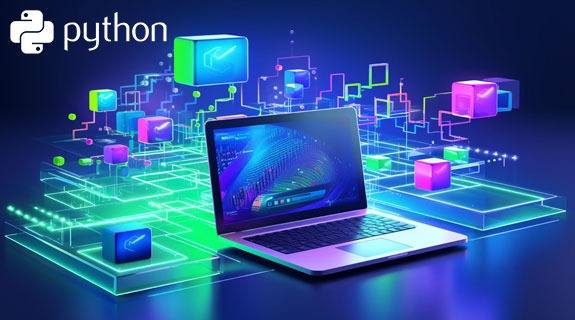Python
- Home
- Python
Python Training
- Python is a general-purpose interpreted, interactive, object-oriented, and high-level programming language. It is known for being flexible, powerful, and easy to learn and use, with powerful libraries for data manipulation and analysis.
- For over a decade, Python has been utilized in scientific computing and highly quantitative domains such as finance, oil and gas, physics, and signal processing.

- It remains a favorite among data scientists for building and using machine learning applications and other scientific computations.
- Python significantly reduces development time with its easy-to-read syntax and straightforward compilation features.
- Debugging programs is effortless in Python thanks to its built-in debugger.
- Python has become the most preferred language for data analytics, with increasing search trends indicating its prominence and necessity for professionals in the data analytics domain.
Send an Enquiry
Python Syllabus
Introduction
- What is Python?
- WHY PYTHON?
- History
- Features – Dynamic, Interpreted, Object oriented, Embeddable, Extensible, Large standard libraries, Free and Open source
- Why Python is General Language?
- Limitations of Python
- What is PSF?
- Python implementations
- Python applications
- Python versions
- PYTHON IN REALTIME INDUSTRY
- Difference between Python 2.x and 3.x
- Difference between Python 3.7 and 3.8
- Software Development Architectures
Python Software’s
- Python Distributions
- Download &Python Installation Process in Windows, Unix, Linux and Mac
- Online Python IDLE
- Python Real-time IDEs like Spyder, Jupyter Note Book, PyCharm, Rodeo, Visual Studio Code, ATOM, PyDevetc
Python Language Fundamentals
- Python Implementation Alternatives/Flavors
- Keywords
- Identifiers
- Constants / Literals
- Data types
- Python VS JAVA
- Python Syntax
Different Modes of Python
- Interactive Mode
- Scripting Mode
- Programming Elements
- Structure of Python program
- First Python Application
- Comments in Python
- Python file extensions
- Setting Path in Windows
- Edit and Run python program without IDE
- Edit and Run python program using IDEs
- INSIDE PYTHON
- Programmers View of Interpreter
- Inside INTERPRETER
- What is Byte Code in PYTHON?
- Python Debugger
Python Variables
- bytes Data Type
- byte array
- String Formatting in Python
- Math, Random, Secrets Modules
- Introduction
- Initialization of variables
- Local variables
- Global variables
- ‘global’ keyword
- Input and Output operations
- Data conversion functions – int(), float(), complex(), str(), chr(), ord()
- bytes Data Type
- byte array
- String Formatting in Python
- Math, Random, Secrets Modules
- Introduction
- Initialization of variables
- Local variables
- Global variables
- ‘global’ keyword
- Input and Output operations
- Data conversion functions – int(), float(), complex(), str(), chr(), ord()
Operators
- Arithmetic Operators
- Comparison Operators
- Python Assignment Operators
- Logical Operators
- Bitwise Operators
- Shift operators
- Membership Operators
- Identity Operators
- Ternary Operator
- Operator precedence
- Difference between “is” vs “==”
Input & Output Operators
- Input
- Command-line arguments
Python Modules
- Importance of modular programming
- What is module
- Types of Modules – Pre defined, User defined.
- User defined modules creation
- Functions based modules
- Class based modules
- Connecting modules
- Import module
- From … import
- Module alias / Renaming module
- Built In properties of module
Packages
- Organizing python project into packages
- Types of packages – pre defined, user defined.
- Package v/s Folder
- py file
- Importing package
- PIP
- Introduction to PIP
- Installing PIP
- Installing Python packages
- Un installing Python packages
Python Logging
- Logging Levels
- implement Logging
- Configure Log File in over writing Mode
- Timestamp in the Log Messages
- Python Program Exceptions to the Log File
- Requirement of Our Own Customized Logger
- Features of Customized Logger

